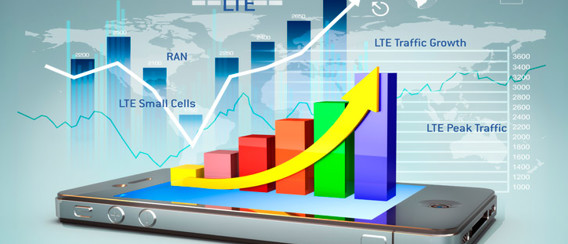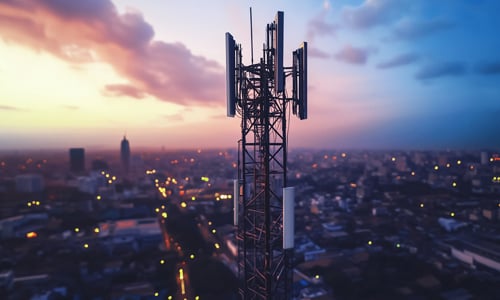Who needs LTE small cells first?
LTE operators across the world have initiated various deployment strategies regarding band, spectrum size and radio access network (RAN) integration with legacy technology. Those who deployed LTE using a 10-MHz (or less) band at sub-1 GHz as an overlay completed their projects ahead of their competitors. Depending on the density of their initial deployments, these operators will likely be the first to deploy small cells. Fortunately, this is a reflection of their success.
Let’s imagine a mobile network with 1M subscribers. If the average subscriber downloads 1 Gigabyte per month in 2013, the peak traffic during the busiest minute of the busiest hour of that month corresponds to approximately 24 Gbit/s[1]. Assuming a 50% year-on-year growth (recently cited by Ericsson[2]) over the next five years and factoring in the increase in LTE device penetration as well as expanding coverage, it is possible to calculate LTE traffic growth for this network.
This graph shows that in five years, the significant shift in traffic from 3G to LTE could cause LTE peak traffic to increase 70 fold. Obviously, this substitution rate will differ from network to network but for high average revenue per user (ARPU) markets like North America, Japan, South Korea and to a lesser extent Western Europe, such rapid growth is very likely. As a matter of fact, Verizon passed the 50% mark less than three years after introducing LTE.
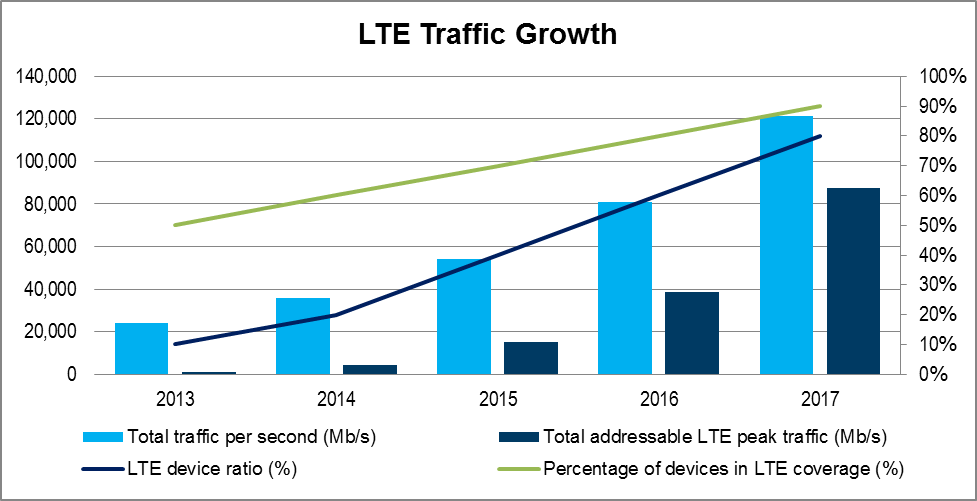
Let’s apply the normalized traffic growth figures of a 1M-subscriber network to a network consisting of six cities with varying population and area, located in a highly industrialized country. In this example, the operator has 30% subscriber penetration.

Holma and Toskala calculated LTE cell sizes of 10 sq-km (700/800 MHz), 4 sq-km (1800/1900 MHz) and 3.2 sq-km (2100 MHz) for a cell-edge performance of 1 Mbit/s in a suburban environment[3]. An additional cell overlap factor of 20% is applied to allow handovers to these area sizes. Furthermore, the non-uniform nature of traffic distribution over a geographic area is considered. This is reflected in this analysis by applying a double Pareto distribution resulting in the following table for different traffic densities.

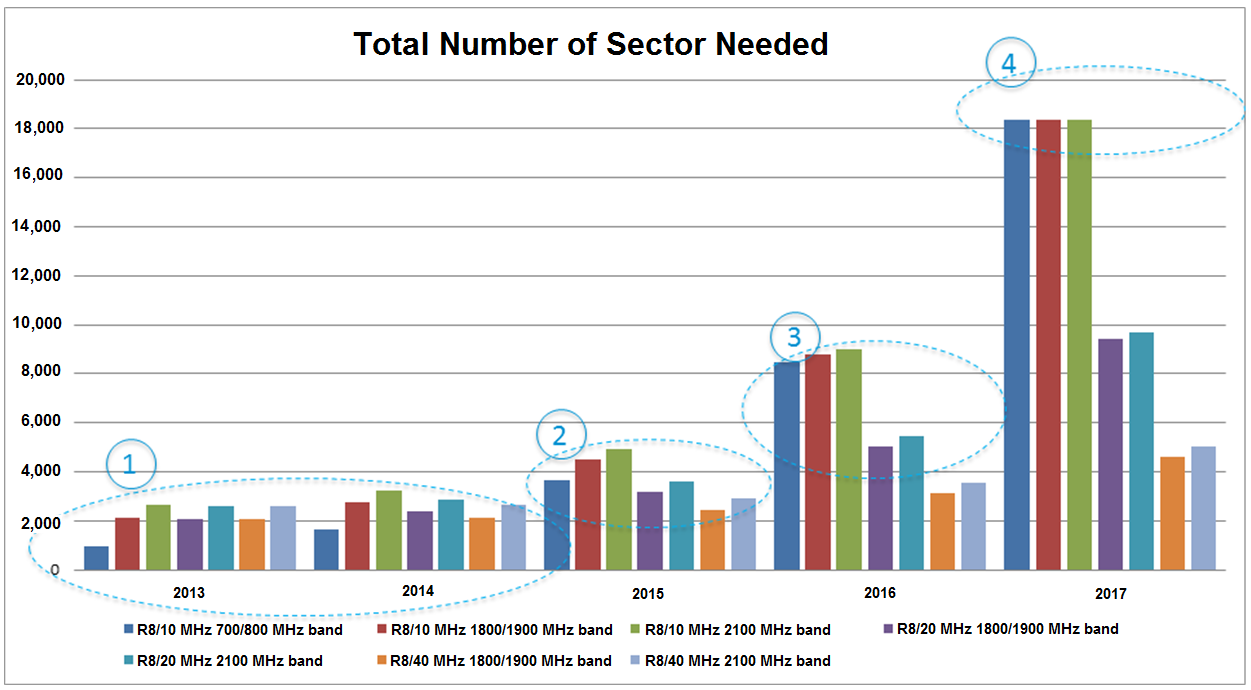
The following are observations concerning sector counts:
- When a network is coverage-limited, using a lower frequency gives a very significant advantage to those operators with a sub-1 GHz spectrum. For early deployments, sparse deployment is sufficient.
- When LTE traffic volume is over 30-35%, the limitations of 10-MHz versus 20-MHz deployments become clear. At this level, the advantages of a sub-1 GHz spectrum disappear because deployment starts to be capacity-limited across the entire coverage area.
- For 10-MHz deployments, the lower spectrum advantages will disappear entirely once the LTE traffic reaches about 50% of the total traffic since, throughout the whole area, deployment is capacity-limited. However, the benefits of 40 MHz through carrier aggregation will become apparent.
- By 2017, the number of eNodeBs in the example network will be staggering and most likely infeasible in a 10-MHz deployment. Even in 20-MHz deployments, within the very high traffic area, a small-cell layer will be essential for carrying most of the traffic. On the other hand, if a 40-MHz spectrum is available, at least within the very high traffic area, the number of small cells can be minimized[5].
Expanding on point 4 of the analysis, let’s consider the very high traffic area of city A. It covers just over 33 sq-km and it may generate as much as 4.6 Gbit/s per sq-km by 2017. Based on this observation, the number of macro and small cells needed to support this dense traffic in 10-, 20- and 40-MHz deployments is shown in the following figure.
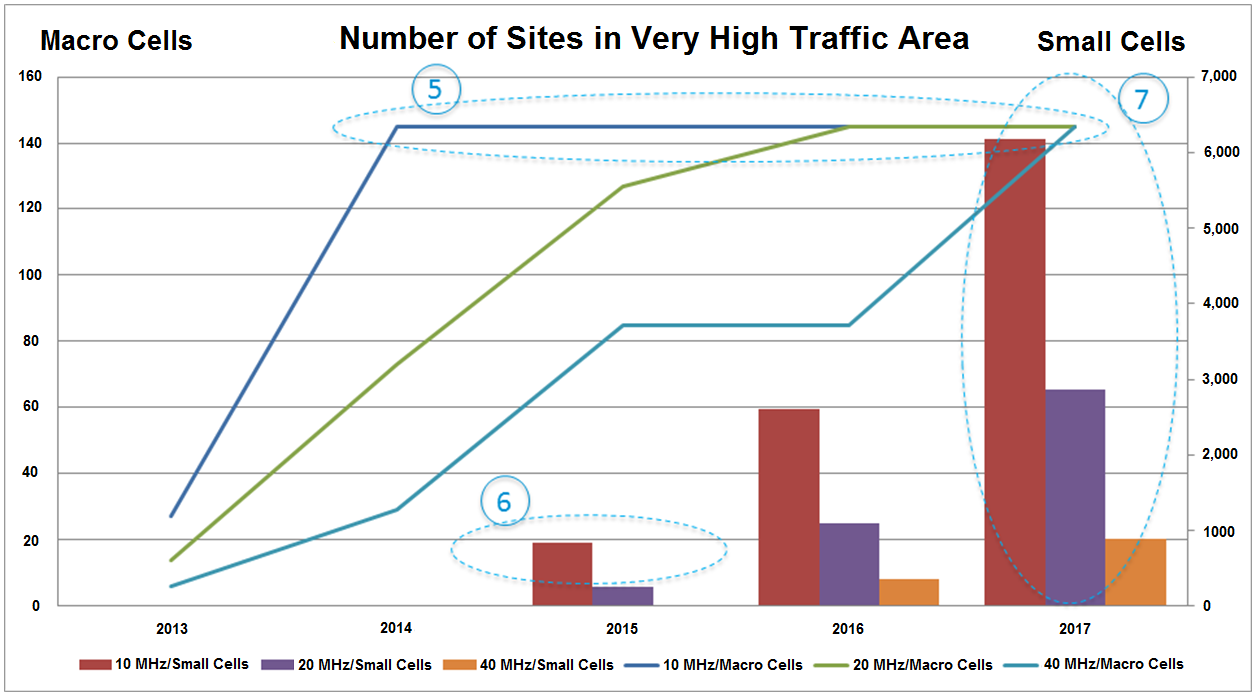
The following are observations concerning the cell counts in a very high traffic area
- In this analysis, the cell radius of the macro cells is at least 300 m, meaning that the maximum number of macro cells is approximately 145. This means that if 20% of an operator’s traffic is carried over the LTE network, it would bring a 10-MHz deployment to its density limits for the macro-cell layer. Whereas for 20 and 40 MHz, the macro-cell layer provides most of the capacity for a much longer time.
- As early as 2015, the number of small cell counts will be very significant if only 10 MHz is available.
- In 2017, when over 80% of the operator’s traffic is carried over LTE, using only 10 or 20 MHz will be rather unrealistic even with a very dense small-cell layer. On the other hand, using a carrier aggregation of 40 MHz will result in a manageable number of small cells with a cell radius approximately 120 m.
So, who will need LTE small cells first? The answer is operators who deployed LTE in lower bands with a smaller spectrum. However, it is not always easy to determine when this transition needs to occur. The likely strategy for those operators is to first deploy a macro 1800/1900-MHz or 2100-MHz network to supplement their sub-1 GHz LTE networks. The next step would be to start deploying small cells at 2.6 GHz, or the emerging 3.5 GHz.
As for operators who started with macro networks at higher bands, the strategy of adding spectrum to LTE at those bands (expanding from 10 to 20 MHz, or using carrier aggregation up to 40 MHz) will delay the need for small cells further. However, such flexibility requires preparing the macro network early on with four antennas to take advantage of 4 x 2 MIMO capabilities, power amplifiers that can support 40 MHz and most likely, separating Base Band Units (BBU) and Remote Radio Units (RRU) with fiber connectivity. Equally important is the fact that the backhaul capacity of the macro network must be upgradeable to allow the peak throughput afforded by 40 MHz.
[3] H. Holma and A. Toskala, “LTE for UMTS: Evolution to LTE-Advanced”, 2nd edition, March 2011.
[4] All macro cells are three-sectored while all small cells are single-sectored.
[5] As of 2013, most small cell products are single-sector with 20-MHz. We anticipate by 2015, either two-sector or 40-MHz small cells eNodeBs will be more prevalent.

